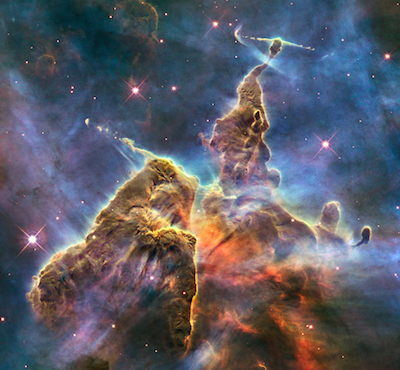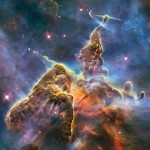By Amanda Painter
On Saturday, the Aries Sun slides right into the square between Pluto in Capricorn and Eris in Aries. As was written about at the beginning of the week, this is part of a long series of era-changing and defining aspects covering the last ten-plus years. Chances are you can see a substantial amount of the change, stress, growth and discovery in your own life in that span of time as a reflection of this astrology; this week’s rumblings may be stirring up some uncertainty and tension — possibly with deep roots, along with great creative potential.

“Mystic Mountain,” a detail from the much more extensive Carina Nebula, via which astronomers are studying the complicated physical processes that form new stars. Photo by NASA, ESA, and M. Livio and the Hubble 20th Anniversary Team (STScI)
One thing that could feel tricky about it, though, is getting a handle on how this energy is coming through for you personally.
Eris and Pluto move slowly; they tend to describe generational (or longer) processes.
Pluto, in particular, drives social (and, in Capricorn, institutional) evolution by breaking down what’s no longer functioning constructively. Eris adds a destabilizing factor: an element of chaos, subversion and (in its recent association with Uranus) provocation via the ways we define identity itself.
Another thing that might be challenging right now — yet easier to grasp — is the lingering effects of Mercury, and now Venus, moving through the focus-dissolving, imagination-distracting, and enticingly escapist field of Neptune in Pisces. Mercury is also still working through its post-retrograde shadow phase (it exits for new astrological turf on April 16). I’m hearing from a number of people comments about how this is still feeling a bit hiccup-y. It’s okay to continue taking things as slowly and deliberately as you need to.
Looking at Saturday’s chart, I noticed an interesting complement of minor objects in close contact with the Sun-Pluto-Eris aspect. I think they paint a fairly clear thematic picture, whether applied personally as you see fit, or culturally. I’m going to list them briefly.
In Aries we have the asteroid Siwa — named after a Slavic fertility goddess — early in the same degree as the Sun and Eris. Three or so degrees on the other side of Eris is the asteroid Terpsichore, named after the Greek Muse of dance.
In Cancer, the centaur object Cyllarus is sharing the same degree as the lunar North Node. Some astrologers associate Cyllarus with pride in identity and self-worth (it’s also closely associated with the female centaur Hylonome in myth: she killed herself in grief after he was killed in battle by a spear from an unknown source). In any case, all centaurs point to processes of awareness, which can then be used for healing old patterns.
In Libra, the dwarf planet Haumea is a couple of degrees square Pluto and opposite Sun-Eris. Haumea is a Hawaiian creation goddess who birthed many offspring from various parts of her body.
Finally, in Capricorn, the object Arawn is within the conjunction of Saturn (authority, structure, and an agent of change), the lunar South Node, and Pluto. Arawn is named for the Celtic underworld King of the Dead. Just on the other side of Pluto, a couple of degrees away, is the asteroid Eurydike — a Greek nymph who was wife to the musician Orpheus (who tried to bring her back from the dead); Eurydike is associated with a longing to return to what is past, lost or outmoded.
The first thing that jumped out at me was the presence of creation-related objects on the Aries-Libra axis (Siwa, Haumea and, if you think of dance as creativity, Terpsichore); and of death- or release-related objects on the Cancer-Capricorn axis (Cyllarus, Arawn and Eurydike). Then add in the lunar nodes — which relate to the location of eclipses and their release-and-pattern-setting effects, as well as to the ideas of past/habit/karma (South Node) and future/the unknown/dharma (North Node).
It would seem the cosmos is sending a rather emphasized message here: about our choices and actions, and how we can use them right now to actively shape who we are in the world — a world that has become so increasingly lived on auto-pilot, many feel powerless to stop the glaring, global crimes of government and business. Many people are struggling to push down the fear and hopelessness that can well up in the face of our collective shadow being played out by so many — and then live-streamed, Tweeted and argued about on social media.
Yet, as I was doing a little extra research on these minor objects, something Eric wrote about Haumea in 2017 jumped out at me. He was writing about Haumea in contact with Jupiter (which was in Libra at the time) and with the Uranus-Eris conjunction in Aries, but I think it applies just as much today as it did then.
He said, “Haumea is the cosmic midwife. Its presence indicates that there is, beneath all the chaos, a birthing process underway, and that we’re likely to find it in our relationships (via Libra). This is an abstract thought in the age of texting as intimacy.”
Abstract as that thought may be, I’d say this moment is about what we let die (or let go of — or what forms of metaphorical death or hell we’re willing to go through) in the process of creating and bringing forth new life, new art, and a more present, vital sense of self. As has always been the case on this planet of carbon-based life forms and interdependent ecosystems, the two processes are part of one coherent, whole cycle.
It is all about relationships: from the relationships between our own cells, to the relationships we have with other people and organisms — in actual, physical, emotional and energetic proximity. It’s about the relationships between ourselves and the systems we’re part of (those we build, tear down and build again, including technological; and the planet’s natural systems).
The one centaur in close proximity to this aspect pattern is in Cancer: the sign of cycles, of mothers and mothering, of sensitivity and caring. I might ask: in the process of whatever we, collectively, are releasing and birthing, and in whatever you, personally, are allowing to fall away and what you are bringing forth, what and who do you care about, and how do you do it? Who are you in your caring? How do you bring your caring from the realm of emotion into the tangibility of action? It does not just come out of nowhere, and it does not land randomly.

As we go deeper into this most unusual and challenging phase of history, intelligence is the thing we need the most. That is the theme of the 2019-2020 annual edition of Planet Waves — audio and written signs available for instant access. See more information here. If you’re looking for individual signs, order here.


Beautiful. Thank you, dear Amanda. xxx
Yassss BeautifulAmanda!! (That looks awesome!)
My take. Our only ‘caring’ i.e. focus is called upon oneself (one’s self)
Our heart and our soul want OUR BODY to get her. That is the sole purpose of our trip (beware of tripping).
Blessings EveryOne!!
Grateful to hear it, Lizzy, Linda May and Sara Victoria. It was hard to know last night if it hung together quite as well as I’d hoped.
Beware of tripping, indeed! It really can be a beautiful trip when we choose to make it so.
Awesome piece, Amanda. Thank you.
https://www.sott.net/article/410905-First-ever-black-hole-image-has-been-released
For Your Info Guys n Gals 🙂
Listened to a presentation today by Melanie Reinhart on the centaur Chariklo (Chiron’s wife) and her involvement in the upcoming Saturn Pluto conjunction. Melanie recognized a handful of astrologers at the beginning of her presentation, including Eric Francis, for sharing their insights and companionship on the centaur journey.
Thank-you Amanda for continuing the PW tradition of exploring these minor objects.